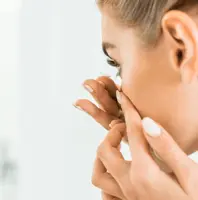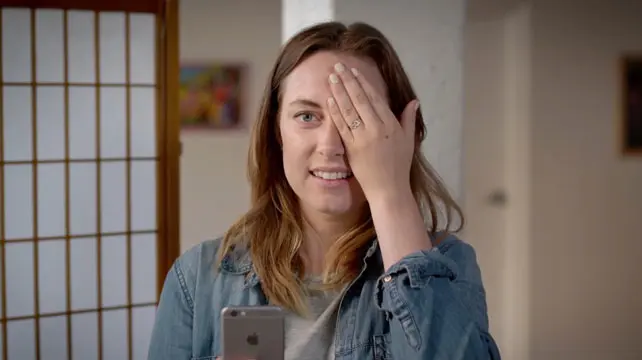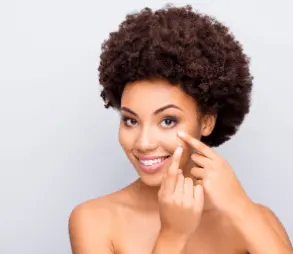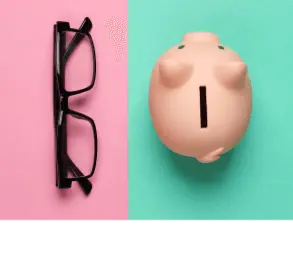Caring For Teen's Eyes
Having teenagers is an adventure in itself. Between school, extracurricular activities, and their social life, finding time to ensure they’re also taking care of their eyes is hard. Choosing the right eyecare for teens is essential to keeping their eyes healthy for the rest of their life. Whether you’re shopping for glasses for teens, trying to find the best contacts for teens, or just curious about what questions to ask your teen’s eye doctor, we’ve got you covered with everything you need to know about caring for your teen’s eyes.
• Optometrist or ophthalmologist
• The pros and cons of contacts
• The pros and cons of glasses
• Blue light glasses
• Choosing sunglasses
Eyecare for Teens: Optometrist or Ophthalmologist?
When you’re trying to provide the best eyecare for teens, the first step is to find the best eye doctor. However, chances are you still have questions before you’re ready to make an appointment, like, “What kind of eye care professional do I need?” “What is an optician?” and “What is the difference between an optometrist and an ophthalmologist?”
The answer to the first question about eyecare for teens depends on your preference and your child’s needs. The most significant difference between professionals offering eyecare for teens is the level of education each has. Opticians specialize in finding the best fit for glasses and brands of contacts for teens and adults. Once you receive a prescription, an optician will help determine the best glasses for teens. Although opticians typically work in an eye care office, they don’t write prescriptions or provide examinations. Here are the main differences and similarities between an optometrist and an ophthalmologist:
• Education: Optometrists attend optometry school for four years and then generally complete a year of residency. Ophthalmologists attend four years of medical school, followed by four years of residency. Many ophthalmologists also complete a fellowship lasting one or two years in an area of specialties such as pediatrics or cataracts.
• Services: The most significant difference between the services that each specialty offers comes down to surgery. Optometrists provide general eyecare for teens and adults. However, optometrists do not perform surgery, while ophthalmologists can treat all aspects of your eyes as well as laser eye surgery, medical and surgical eye care, and even plastic surgery involving the eyes.
Optometrists perform routine eyecare for teens and adults, including:
• Eye exams and vision tests
• Treat a variety of eye conditions including astigmatism, nearsightedness, and farsightedness
• Prescribe the correct level of glasses and contacts for teens
• Diagnose and treat injuries, diseases, and disorders of the eyes
• Provide vision therapy
Ophthalmologists perform general eyecare for teens and adults as well as:
• Medical treatment for chemical burns, glaucoma, iritis, and more
• Surgical correction for trauma, cataracts, and Lasik eye surgery
• Diagnose and treat eye conditions associated with illnesses including arthritis and diabetes
• Perform plastic surgery to lift sagging eyelids or smooth wrinkles
Contacts for Teens: Pros and Cons
Whether you’re
shopping for glasses or contacts for teens, each has its own set of pros and cons. Depending on their age, choosing contacts for teens is a great way to improve vision and other eye problems without attracting attention. There are several advantages to choosing contacts for teens that stand out.
Unlike glasses, contacts for teens offer fewer obstructions and distortions than glasses because they sit directly on the eye. Contacts are a fantastic choice for athletes because they provide an unobstructed line of sight. Also, glasses can be dangerous when playing contact sports such as basketball or soccer. If something hits your teen in the face with a high level of force, glasses may break and cut or injure the face. As long as they are comfortable, we recommend choosing contacts for teens who play sports.
From a medical point of view, some types of contacts for teens can help correct myopia, also known as nearsightedness. Nearsighted people have trouble seeing things that are far away, such as the whiteboard at school, road signs while driving, or details on the television when sitting on the couch. Orthokeratology contacts, also known as Ortho-k contacts, help reshape the cornea while you sleep. Reshaping the cornea allows the person to see clearly the next day without the need for contacts or glasses for teens.
Another perk of choosing contacts for teens is cosmetic reasons. Teenagers may feel self-conscious about wearing glasses, and so selecting contacts for teens is an excellent way to correct vision issues without attracting attention. Contacts can change your eye color as well as correct your vision. Also, there are special effects contacts for teens that wearers can use for Halloween or other fun occasions.
Although there are many advantages to choosing contacts for teens, there are also a few disadvantages to consider. Depending on the age of your teen, they may have trouble inserting contacts into their eyes. Although this is something that is usually easily fixed with practice, it’s essential to consider. While many teenagers are responsible, it’s important to consider the amount of care that contacts for teens take. Contacts must be stored in clean solution daily to avoid eye infections. Doctors who specialize in eyecare for teens and adults also remind people that unless their contacts are approved for overnight use, it’s imperative to remove your contacts each night before you go to bed to avoid waking up with red, irritated, and dry eyes. Forgetting to remove your contacts each night can not only lead to painful eyes in the morning, but it can also increase your likelihood of infections.
In addition to the learning curve, contacts also decrease the amount of oxygen that reaches the eye, which can cause or exacerbate the feeling of dry eyes. There are also things to consider when choosing contacts for teens who work on computers for hours each day. Contacts for teens and adults do not currently have filters for blue light, meaning that eyes that look at screens for long periods can experience symptoms of computer vision syndrome and digital eye strain.
Glasses for Teens: Pros and Cons
Just like there are for contacts for teens, there are several pros and cons of selecting glasses. Eyeglasses are a popular form of corrective eye devices, as well as part of ongoing fashion trends. There are a few main advantages that stand out when evaluating glasses for teens.
Unlike contacts, selecting glasses for teens reduces the number of times you touch your eyes. The more you rub your eyes, the more likely you are to get an eye infection. Also, choosing glasses for teens who have dry eyes will help increase the amount of oxygen the eyes are exposed to throughout the day. Although several contact lens brands utilize materials that offer higher levels of oxygen transmission and moisture agents, if your teenager suffers from dry eyes, choosing glasses for teens may be the better option.
From a price point, glasses tend to be the cheaper alternative when you compare them to contacts for teens because of their longevity. Contacts need to be replaced at least every month, depending on the brand and style, whereas glasses for teens should last for years. When your prescription changes, you can choose to browse new glasses for teens, or you can ask your optician about using the same frames and replacing the lenses.
Glasses for teens also offer a variety of ways to express their personality and style. Frames can be bold, blend in, and even become sunglasses. Glasses also protect from the effects of wind, dirt, and debris.
Although there are several advantages to selecting glasses for teens, glasses come with disadvantages as well. For many people, the issues are cosmetic; for others, there are physical disadvantages to take into consideration.
Unlike contact lenses for teens, glasses don’t sit directly on top of your eyes. When people begin wearing glasses, many note that looking through the lenses as opposed to having a real peripheral vision can be off-putting. In addition, glasses can become subject to the elements. For example, rain may accumulate on the lenses, making it difficult to see, or the transition between hot and cold environments can lead to lenses that fog up and collect condensation. From a physical standpoint, glasses can also be uncomfortable for some people. Some frame styles place pressure on the nose and above or behind the ears. This pressure can create headaches and overall feelings of discomfort. In these situations, it may be better to choose contacts instead of glasses for teens.
As with most things, there are also cosmetic preferences to consider when debating eyecare for teens. Some people don’t like the way their face looks in glasses. If you have a particularly strong prescription, it’s also possible that the thick lenses may change the look of your eyes when viewed through your glasses. For example, eyes may appear unnaturally smaller or more significant due to the way that the frames of the lenses are made. When choosing glasses for teens that may be self-conscious, it’s essential to find the best style or to opt for contacts.
Eyecare for Teens: Blue Light Glasses
If you work on a computer or interact with other screens for extended periods, chances are you’ve experienced a headache or tired eyes at one point or another. In the past few years, blue light glasses have become more popular as a way to help reduce the impact that screens and other blue light-emitting devices have on the eyes of those who use them.
When thinking about eyecare for teens, blue light reduction is an essential factor to consider. If your teenager uses a laptop or tablet to complete work for class or their job, looking into blue light glasses for teens can be a smart way to potentially reduce eye strain. Many retailers offer the ability to add blue light blocking technology to glasses, as well as nonprescription blue light glasses for teens who wear contacts.
Eyecare for Teens: Choosing Sunglasses
Protecting your eyes from the damaging impact of the sun is just as important as wearing sunscreen to protect your skin. UV rays can have a drastic effect on the health and wellness of your teen’s eyes. Ensuring that sun protection is a part of your routine eyecare for teens is essential.
There are several different options when it comes to adding UV protection to your routine eyecare for teens:
• Wearing a separate pair of nonprescription sunglasses
• Adding a tint to your lenses
• Adding progressive sun sensors to your lenses
• Adding a polarized tint to your lenses
• Ensuring the brand of contacts for teens you purchase has UV protection
When considering eyecare for teens, there are a variety of sunglass options on the market that range from dirt cheap to the price of a car payment. When dealing with glasses for teens, consider the amount of responsibility you’re comfortable with your teen having before purchasing expensive sunglasses. Regardless of the price, ensure that your purchase of UV blocking glasses for teens blocks 99% to 100% of UVA and UVB rays as well as block 75% to 90% of visible light.
For glasses, one option is to add a tint to the lenses. When discussing general eyecare for teens with your eye doctor, ask their opinion on whether or not this is a good idea. Depending on the price of the lenses, it may be an option to purchase two pairs of glasses for teens: one with no tint for indoors and one with a tint for outdoor use. Another option is to use a sun sensor or progressive lenses. This type of eyecare for teens creates lenses that transition between traditional lenses and sunglasses when exposed to UV light. These glasses for teens are a great option to ensure that your teenager is using their sunglasses!
Adding a polarized tint is another option that helps prevent glare as well as damage from UV rays. According to WebEyeCare, “Polarized lenses help to prevent glare from shiny surfaces like water, snow, and windshields. The protection of polarized lenses comes from filtering the direction of light. This helps you get a clear image, rather than the glare caused by reflected light in all directions. Polarized lenses are great for people who spend lots of time outside, and the polarized technology helps protect your eyes from damaging UV rays, as well as keeping the view nice and sharp.”
WebEyeCare
At WebEyeCare, we supply a variety of products targeting eyecare for teens, including discount prescription contact lenses and glasses. Our knowledgeable staff is here to help you every step of the way in creating the best solutions to address general eyecare for teens. For more information about our products or how to choose the best products for everyone in your family, visit our website!
 Save yourself from getting into rush hours and buy your contacts online.
Save yourself from getting into rush hours and buy your contacts online.






